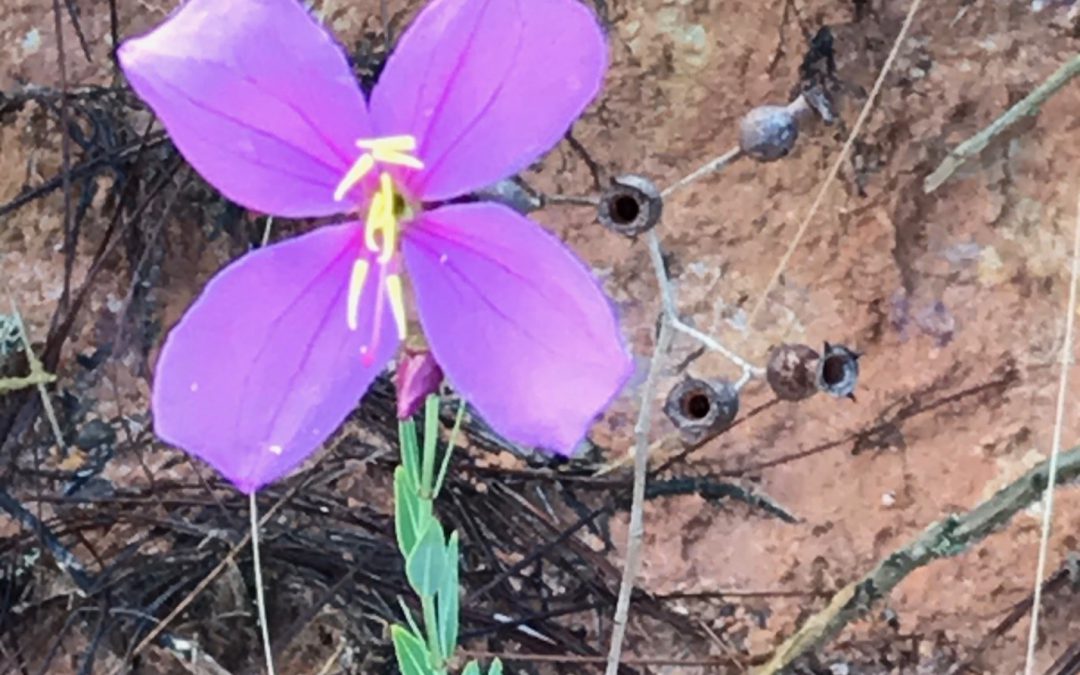
by Sheila Dunning | Jul 9, 2021
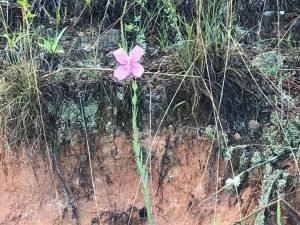
Photo by: Sheila Dunning
Have you noticed the beautiful pink flowers in the meadows near the woods? That’s what many early explorers of Florida may have said, which lead to the common name of Rhexia spp. Meadow beauty (Rhexia spp.) is a Florida native found in mainly moist habitats, including flatwoods, wet meadows, marshes and savannas. Rhexia species are herbaceous perennials that flowers from late spring to fall, going dormant in winter. The simple leaves are simple and oppositely arranged. The flower has four petals, four sepals and eight long, bright orange-yellow stamen with curving anthers on the end. The light pink flowers face outward on a 1-2 feet tall stack, each one measuring about an inch across. The unique shape of the stamen and anthers suggests that the Rhexia species are buzz pollinated.
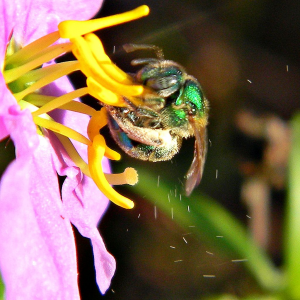
By Bob Peterson from North Palm Beach, Florida, Planet Earth! – Buzz Pollination (Sonication), CC BY-SA 2.0, https://commons.wikimedia.org/w/index.php?curid=38199019
Buzz pollination or sonication is a technique used by some bees to release pollen which is firmly held by the anthers. The anthers of buzz-pollinated plant species are typically tubular, with an opening at only one end, and the pollen inside is smooth-grained and firmly attached. In order to release the pollen, the bees grab onto the flower and move their flight muscles rapidly, causing the flower and anthers to vibrate, dislodging pollen. Honeybees cannot perform buzz pollination. Only about 9% of the flowers in the world are primarily pollinated using buzz pollination. So, meadow beauty is not just pretty, it has a unique connection with native bees.
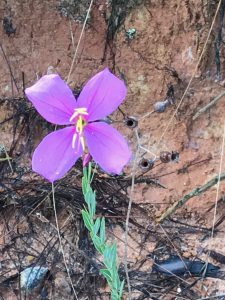
Photo by: Sheila Dunning
Meadow beauty grows in full sun or partial shade. The plant can reproduce by seeds and underground rhizomes. Rhexia spp. are also a tasty treat for deer as they graze in the meadow. The flowers don’t last long and can’t handle being touched. In Greek, Rhexia means “breaks”. So, enjoy them as you walk through the woods, but leave them for the bees rather than picking them.
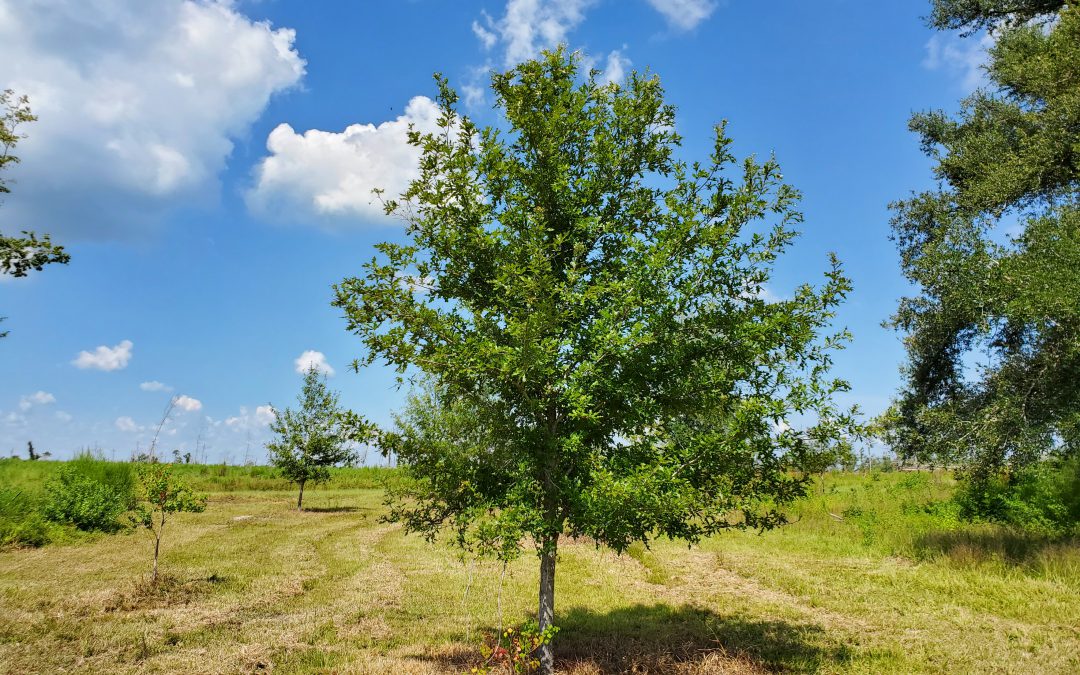
by Daniel J. Leonard | Sep 3, 2020
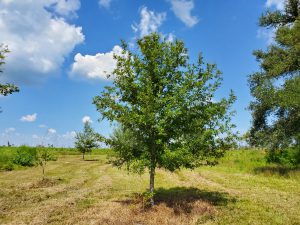
Overcup on the edge of a wet weather pond in Calhoun County. Photo courtesy of Daniel Leonard.
Haunting alluvial river bottoms and creek beds across the Deep South, is a highly unusual oak species, Overcup Oak (Quercus lyrata). Unlike nearly any other oak, and most sane people, Overcups occur deep in alluvial swamps and spend most of their lives with their feet wet. Though the species hides out along water’s edge in secluded swamps, it has nevertheless been discovered by the horticultural industry and is becoming one of the favorite species of landscape designers and nurserymen around the South. The reasons for Overcup’s rise are numerous, let’s dive into them.
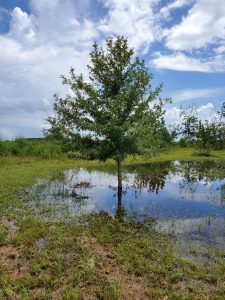
The same Overcup Oak thriving under inundation conditions 2 weeks after a heavy rain. Photo courtesy Daniel Leonard.
First, much of the deep South, especially in the Coastal Plain, is dominated by poorly drained flatwoods soils cut through by river systems and dotted with cypress and blackgum ponds. These conditions call for landscape plants that can handle hot, humid air, excess rainfall, and even periodic inundation (standing water). It stands to reason our best tree options for these areas, Sycamore, Bald Cypress, Red Maple, and others, occur naturally in swamps that mimic these conditions. Overcup Oak is one of these hardy species. It goes above and beyond being able to handle a squishy lawn, and is often found inundated for weeks at a time by more than 20’ of water during the spring floods our river systems experience. The species has even developed an interested adaptation to allow populations to thrive in flooded seasons. Their acorns, preferred food of many waterfowl, are almost totally covered by a buoyant acorn cap, allowing seeds to float downstream until they hit dry land, thus ensuring the species survives and spreads. While it will not survive perpetual inundation like Cypress and Blackgum, if you have a periodically damp area in your lawn where other species struggle, Overcup will shine.
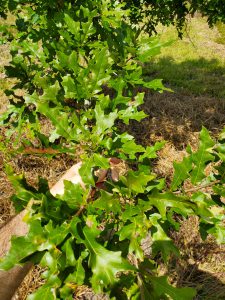
Overcup Oak leaves in August. Note the characteristic “lyre” shape. Photo courtesy Daniel Leonard.
Overcup Oak is also an exceedingly attractive tree. In youth, the species is extremely uniform, with a straight, stout trunk and rounded “lollipop” canopy. This regular habit is maintained into adulthood, where it becomes a stately tree with a distinctly upturned branching habit, lending itself well to mowers and other traffic underneath without having to worry about hitting low-hanging branches. The large, lustrous green leaves are lyre-shaped if you use your imagination (hence the name, Quercus lyrata) and turn a not-unattractive yellowish brown in fall. Overcups especially shine in the winter when the whitish gray shaggy bark takes center stage. The bark is very reminiscent of White Oak or Shagbark Hickory and is exceedingly pretty relative to other landscape trees that can be successfully grown here.
Finally, Overcup Oak is among the easiest to grow landscape trees. We have already discussed its ability to tolerate wet soils and our blazing heat and humidity, but Overcups can also tolerate periodic drought, partial shade, and nearly any soil pH. They are long-lived trees and have no known serious pest or disease problems. They transplant easily from standard nursery containers or dug from a field (if it’s a larger specimen), making establishment in the landscape an easy task. In the establishment phase, defined as the first year or two after transplanting, young transplanted Overcups require only a weekly rain or irrigation event of around 1” (wetter areas may not require any supplemental irrigation) and bi-annual applications of a general purpose fertilizer, 10-10-10 or similar. After that, they are generally on their own without any help!
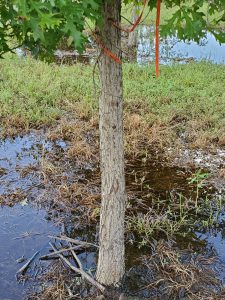
Typical shaggy bark on 7 year old Overcup Oak. Photo courtesy Daniel Leonard.
If you’ve been looking for an attractive, low-maintenance tree for a pond bank or just generally wet area in your lawn or property, Overcup Oak might be your answer. For more information on Overcup Oak, other landscape trees and native plants, give your local UF/IFAS County Extension office a call!
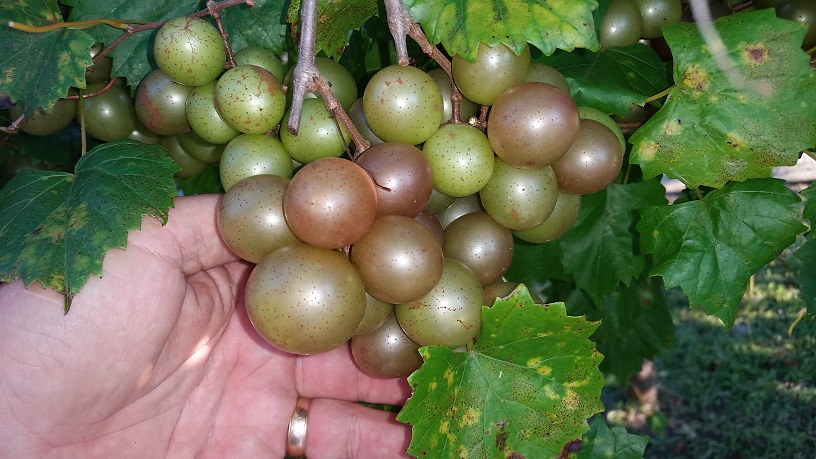
by Erik Lovestrand | Aug 27, 2020
When we moved to the Florida Panhandle in 1989 and bought a house in Wakulla County, my wife and I inherited a grape arbor that was planted by the original builder of the home many years previous. It consisted of three 4×4 posts with cross pieces at the top and a run of heavy gauge wire out near the ends of each cross piece. Maintenance had been lacking for some years so the vines had grown into a massive tangle which at first glance, I surmised I would end up cutting down to help improve the appearance of the property. Well, as is often the case, timing is everything and the existence to this day of that grape arbor, is due to the fact that it was late summer and the vines had some fruit on them. It only took one taste of a sweet, flavorful black muscadine grape to decide they were worth keeping. Little did I know what I was in for though, when it came to properly managing this “wildling” for a productive, beautiful arbor; one that now provides many culinary options, as well as a pleasing, eye-catching aspect in our home landscape.
After looking closer at the vines, it appeared that there were two different species of grapes growing. The very dark purple (almost black) muscadines, were dwarfed by much larger greenish-bronze grapes at one end of the arbor. I now know that these grapes are typically referred to as scuppernongs by most locals and they are actually the same species as the dark grapes. In fact, Vitus rotundifolia is the scientific name for our native wild grapes that have a range from Florida to New Jersey in the east, and west to Texas and Oklahoma. The fruits of this species can be bronze, black or red, depending on the cultivar and they are the same species I remembered picking from wild vines as a youth, which ranged in size from ¼ to ½ inch and were often quite tart. Currently, there are about 150 cultivars of muscadine grapes grown for their fruit and their innate resistance to pests and diseases.
The reason for the two varieties on our grape arbor had to do with the fact that many muscadines produce only pistillate flowers and require pollen from another variety to produce fruit. A few varieties have perfect flowers and can produce fruit on their own, notably Carlos and Noble. Writings about these native grapes date back to the early 1500’s as early explorers of the Cape Fear River Valley in modern-day North Carolina described its abundance and pleasing qualities. The common name “scuppernong” is derived from the Scuppernong River in North Carolina but the name has many variations depending on the locale (scuplin, scufalum, scupanon, scupadine, scuppernine, scupnun, and scufadine). The word “scuppernong” comes from the Algonquian “askuponong,” meaning “place of the askupo,” which is the sweet bay tree (Magnolia virginiana). Cultivation has been recorded as early as the 17th century and with over 100 years of breeding, several bronze cultivars such as Carlos, Doreen, Magnolia and Triumph, are distinguished by having perfect flowers. There is one particular vine on Roanoke Island North Carolina that is considered by many to be the “Mother Vine” for all modern day varieties. This vine has been cultivated for around 400 years, to-date.
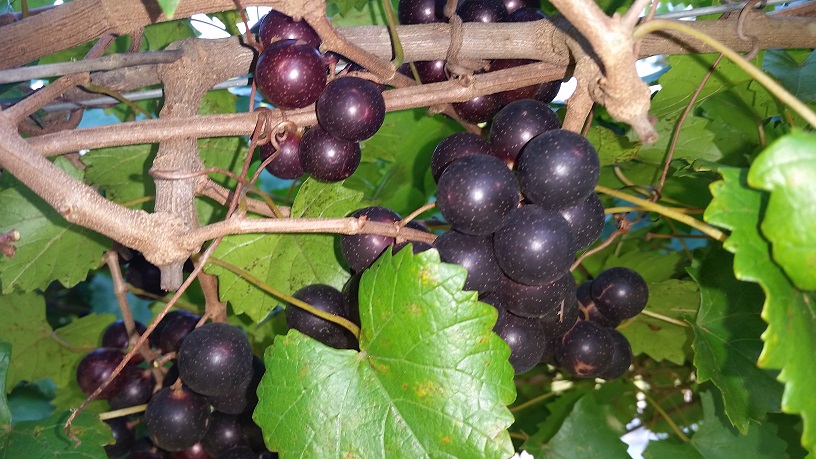
Dark purple muscadine grapes are often called “black grapes.”
If by this time, you are working up a craving for a taste of muscadines, you are not alone because late-summer is the peak production period for many vines around the region. If you do not have your own vines, you are still able to get these grapes at several places around our area. Visit this link for a list of wineries and vineyards in Florida, some of which run u-pick operations. Or you may even have a nearby neighbor with an abundance of fruit and generosity. Some cultivated varieties are suitable for table fare as they have fewer seeds and thinner skins. The tougher-skinned varieties are suitable for jellies, jams, grape butter, and wine making. Bronze scuppernongs produce a very light-colored wine with a mild fruity flavor, while the dark purple muscadines derive a dark reddish, and stronger flavored wine. No matter the type of muscadine, they all provide important habitat and food for many wild critters as well. Thankfully, they generally produce enough bounty to go around and I never begrudge the opossums, raccoons, squirrels and birds their share of the blessing.
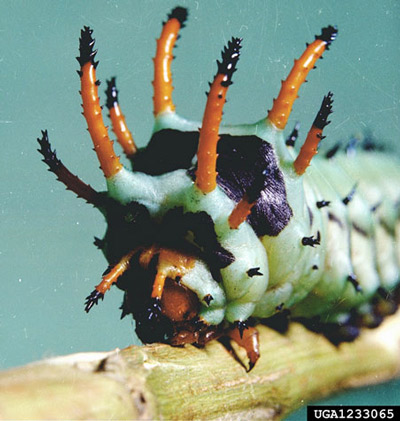
by Sheila Dunning | Jul 16, 2020
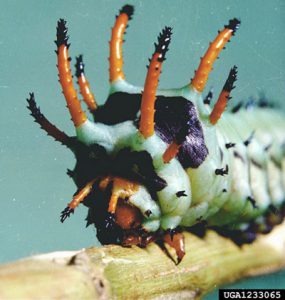
Credits: Clemson University, www.insectimages.org
The hickory horned devil is a blue-green colored caterpillar, about the size of a large hot dog, covered in long black thorns. They are often seen feeding on the leaves of deciduous forest trees, such as hickory, pecan, sweetgum, sumac and persimmon. For about 35 days, the hickory horned devil continuously eats, getting bigger and bigger every day. In late July to mid-August, they crawl down to the ground to search for a suitable location to burrow into the soil for pupation. While the hickory horned devil is fierce-looking, they are completely harmless. If you see one wandering through the grass or across the pavement, help it out by moving it to an open soil surface.
The pupa will overwinter until next May to early-June, at which time, they completely metamorphosize into a regal moth (Citheronia regalis). Like most other moths, it is nocturnal. But, this is a very large gray-green moth with orange wings, measuring up to 6 inches in width. It lives only about one week and never get to eat. In fact, they don’t even have a functional mouth. Adults mate during the second evening after emergence from the ground and begin laying eggs on tree leaves at dusk of the third evening. The adult moth dies of exhaustion. Eggs hatch in six to 10 days.
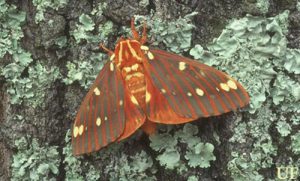
Adult regal moth, Citheronia regalis (Fabricius).Credits: Donald W. Hall, UF/IFAS
The regal moth, and its larvae stage called the hickory horned devil, is native to the southeastern United States. The damage they do to trees in minimal. Learning to appreciate this “odd” creature is something we can all do. For more information: https://edis.ifas.ufl.edu/pdffiles/IN/IN20900.pdf
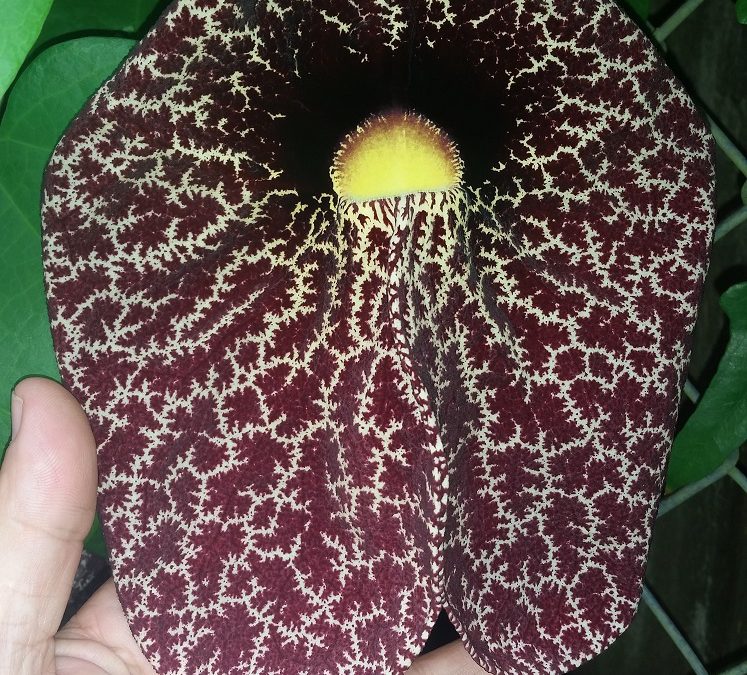
by Erik Lovestrand | Jul 3, 2020
Most people have heard about bug-trapping plants that sustain themselves by digesting and absorbing nutrients from bugs that they catch. This gives them the ability to grow in soils of low fertility that most other plants cannot tolerate. Good examples of this in our Florida Panhandle area include several species of pitcher plants, Venus flytraps (non-native), bladderworts, sundews and butterworts. Some trap their unsuspecting prey by “trickery” with the temptation of sweet but sticky droplets. Others draw prey by the allure of various scents and as the bugs crawl down a narrow passage for the “treat”, one-way hairs prevent them from crawling back out; the “trick.”
One-way hairs is the strategy employed by the Dutchman’s Pipe (Aristolochia littoralis), surely one of the oddest looking flowers on the planet. Also called the “calico flower,” this non-native species of Aristolochia, superficially resembles the Dutchman’s pipe that the famed Sherlock Holmes smoked.
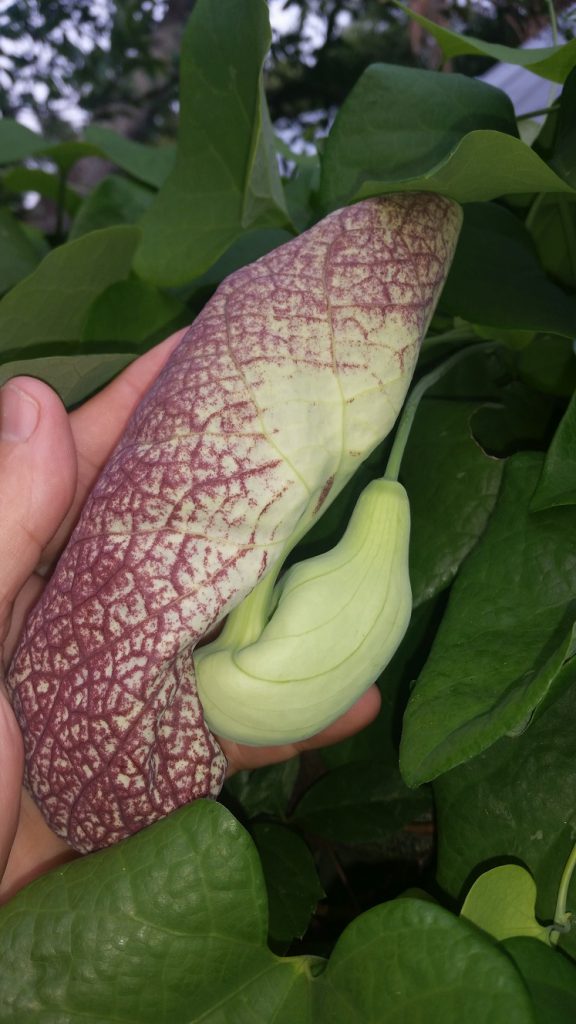
A side-view of the still-closed petals and bulbous reproductive chamber.
The plant is listed as a category II invasive on the Florida Exotic Pest Plant Council’s 2017 List of Invasive Plant Species. Florida also has three native species of Aristolochia, some of which are important larval foods for the pipevine swallowtail. However, there are several non-natives that are actually toxic to butterfly larvae. All of the plants contain a chemical compound called Aristolochic acid, which is considered a strong carcinogen and has been linked to cancer in people who have used this plant as an herbal remedy. The plant has also been found to be a potent kidney toxin and many people have required renal transplants or dialysis as a result of using herbal remedies containing aristolochic acids.
Aristolochia is not alone in the world of bug attracting plants or fungi when it uses a fragrance resembling rotting meat as bait. The unique feature of this plant comes in the trapping strategy that is employed. When a fly is lured down the one-way, hairy tube into the bulbous chamber that serves to hold it’s captor, the flowers reproductive structures are encountered. During the fly’s exploration of the chamber, with no way out, pollen granules adhere to the fly’s body. Amazingly, within a day or so, the stiff hairs blocking the tubular entrance to the prison gradually relax or breakdown, allowing the fly to escape. Scientists who study these flowers all concur that a fly must have a very short memory because it isn’t long before the recent captor ventures into another Aristolochia trap to complete the flower’s pollination process.

Tiny hairs lining the tube leading to the chamber prevent escape, for a time.
The flower itself is an amazing structure of graceful lines, purplish-brown calico patterns and a bulbous reproductive chamber. However, the story behind the marvelous reproductive strategy of the plant is the hidden gem. Be aware though, that this is not a plant that would be recommended for our Panhandle flower gardens due to its habit of invading wildlands. Oh, now that you’ve struggled through this entire article trying to pronounce Aristolochia in your head, here is how you say it: uh-wrist-oh-low-kee-uh. Good luck with that.

by Carrie Stevenson | May 8, 2020

In ecology, a “keystone” species is as crucial to an ecosystem as the central stone in this arch.
In architecture, a “keystone” is the top, central block in an arch structure, the one that holds the entire building up. Without it, the bricks around it collapse. With it, there is nothing stronger.
So, when you hear an animal referred to as a “keystone” species, it should get your attention—especially when that species is listed as threatened by state and federal wildlife agencies. In northwest Florida, one of the species upon which the entire longleaf ecosystem is built is the humble gopher tortoise (Gopherus polyphemus).
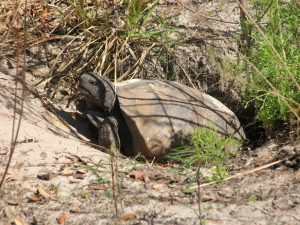
Gopher tortoises are long-lived, protected by their thick shells and deep burrows. Photo credit: Carrie Stevenson, UF IFAS Extension
Once hunted for food and currently in competition with humans for buildable land, this long-lived reptile is an architect in its own right. The tortoises are called “gophers” because of their tunnel building and burrow construction expertise. The tortoises spend about 80% of their time near their burrows, of which they have multiple over their lifetimes. Being a cold-blooded reptile, the burrows allow the tortoises a place to live in the temperature-regulated soil.
The average adult gopher tortoise is about 9-11 inches long, although they can be larger. They have thick feet resembling those of an elephant, and scaly front legs used for digging and burrowing. They are tan, brown, or gray, and live in dry, sandy, upland habitats. Their propensity for dry forestland is typically why their populations are in peril, as this is also the best land for building and development.
The average gopher tortoise’s burrow is 6.5 feet deep and 15-40 feet long, and provides habitat for 350 other species! Those commensal species that share its burrow are mostly invertebrates, but at least 50 are larger backboned species like frogs, snakes, rabbits, and burrowing owls. During forest fires, there are stories of multiple species—from deer and snakes and turtles—calling a truce and hiding in the burrows together until the flames blow over.

Gopher tortoises are nesting right now–be sure to observe from a distance!
Right now—from May to July—is nesting season for gopher tortoises. They lay eggs in the soft sand of their burrow apron, which is the triangular spread of loose sand at the opening of the burrow. Eggs incubate all summer and emerge between August and November. The newly hatched tortoises can expect to live 40 to 60 years in the wild. They live on a variety of grasses and low-growing plants native to longleaf pine, oak forests, and coastal dunes, including wiregrass and gopher apple. They are adapted to routine fires, as they are safe in their burrows and the new growth after a burn provides an abundance of their grassy food sources.




















